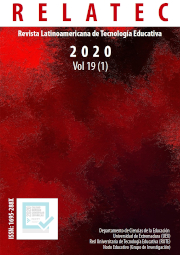Dimensions of the University Digital Ecosystem: Validation of the Instrument «University Digital Ecosystem» (UN-DIGECO)
DOI:
https://doi.org/10.17398/1695-288X.19.1.9Keywords:
Social media, Social network, Digital ecosystem, College students, Digital applications, Survey validationAbstract
The purpose of the study was to design and validate the UN-DIGECO (University Digital Ecosystem) instrument, aimed at learning about the use that undergraduates make of social media and/or digital applications. The content and comprehension validation was carried out in three phases: construction, refining and psychometric validation, based on confirmatory factor analysis, supported by the initial theoretical construct. The items, designed by experts, are in line with indicators assigned to six theoretically defined dimensions: Learning, Social Interaction, Content Creation, Online Consumption, Leisure, and Recreational. Own indicators were integrated together with others adapted from similar published instruments. The preliminary version of the questionnaire was tested by a group of 25 students, some items were refined and redefined to facilitate their understanding. The pilot version included 44 items and involved 484 students from Spanish and Colombian universities. The authors analysed the latent structure of the items by applying exploratory factor analysis and, after examining the composition of the factor structure of the indicators, excluded the non-relevant ones. The results confirmed the existence of these six dimensions, which include 37 items, with a Cronbach's alpha greater than 0.8. The instrument and its components show appropriate psychometric properties of validity and reliability, being applicable to other contexts. The originality of the designed questionnaire lies in the structuring of the information, establishing and integrating six dimensions related to the use university students make of SM.
Downloads
Downloads
Published
Issue
Section
License
Authors who publish in this journal accept the following conditions:
1. The Author retains copyright in the article. Upon acceptance of the article, the author shall grant to the Publisher the right of first publication of the article. with the dcoument registered with the Creative Commons Attribution-NonCommercial-NoDerivative 4.0 International (CC BY-NC-ND) license, which allows to third parties to use what is published whenever they mention the authorship of the work and the first publication in this journal.
2. Authors can make other independent and additional contractual agreements for the non-exclusive distribution of the article published in this journal (eg, include it in an institutional repository or publish it in a book) provided they clearly indicate that the work was published for the first time in this journal.
3. Authors are allowed and recommended to publish their work on the Internet (for example on institutional or personal pages) before and during the review and publication process, as it can lead to productive exchanges and a greater and faster diffusion of published work (see The Effect of Open Access).









